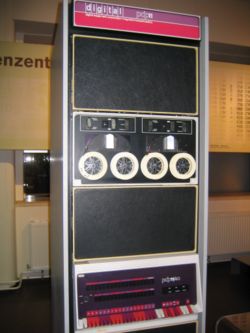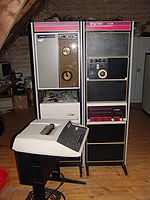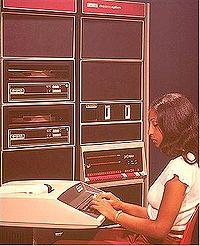Difference between revisions of "PDP-11/40"
m (→Configuration changes: move link) |
(Mention two 10" boxes) |
||
| Line 4: | Line 4: | ||
| caption=PDP-11/40 with [[TU56]] dual [[DECtape]] drive. | | caption=PDP-11/40 with [[TU56]] dual [[DECtape]] drive. | ||
| manufacturer=[[Digital Equipment Corporation]] | | manufacturer=[[Digital Equipment Corporation]] | ||
| + | | year introduced = January, 1973 | ||
| word size= 16 bit | | word size= 16 bit | ||
| virtual address= 16 bit | | virtual address= 16 bit | ||
| physical address= 18 bit | | physical address= 18 bit | ||
| bus arch= [[UNIBUS]]| | | bus arch= [[UNIBUS]]| | ||
| + | | cpu = [[KD11-A CPU|KD11-A]] | ||
|}} | |}} | ||
| + | |||
[[Image:PDP11-40-geerol.jpg|150px|thumb|right|A PDP-11/40 setup.]] | [[Image:PDP11-40-geerol.jpg|150px|thumb|right|A PDP-11/40 setup.]] | ||
The '''PDP-11/40''', introduced in 1973, using the [[KD11-A CPU]], was the second machine to support 18-bit memory addressing on the [[PDP-11]] platform, after the [[PDP-11/45]] (albeit with a subset of the [[PDP-11 Memory Management]] [[architecture]]). | The '''PDP-11/40''', introduced in 1973, using the [[KD11-A CPU]], was the second machine to support 18-bit memory addressing on the [[PDP-11]] platform, after the [[PDP-11/45]] (albeit with a subset of the [[PDP-11 Memory Management]] [[architecture]]). | ||
| + | |||
| + | The [[Original Equipment Manufacturer|OEM]] version of the -11/40 is the '''PDP-11/35'''; the machines are completely identical, except for the printing on the front panel. | ||
| + | |||
| + | It came in two types of [[mounting box]]es: the 21" [[BA11-F Mounting Box]]; and the 10-1/2" [[BA11-D Mounting Box]] and [[BA11-K Mounting Box]]es. | ||
| + | |||
| + | An -11/40 with a special blue front panel was used as the front-end for the [[KL-10]] in [[DECsystem-10]]s and [[DECSYSTEM-20]]s - though the -11/40 panel was hidden behind a cabinet door on the -20. | ||
The 11/40 was also a primary platform for early [[UNIX]]. | The 11/40 was also a primary platform for early [[UNIX]]. | ||
| Line 17: | Line 26: | ||
==Configuration changes== | ==Configuration changes== | ||
| − | Early versions of the -11/40 omitted the 4 fans at the bottom of the pull-out | + | Early versions of the BA11-F in the -11/40 omitted the 4 fans at the bottom of the pull-out used to house the [[Central Processing Unit|CPU]], and had only the 5 fans at the top. |
| − | The [[power | + | The BA11-D used 9-pin [[DEC power distribution connectors]], whereas the BA11-K used the 6-pin/15-pin pair, so presumably the [[backplane]] for the BA11-D had a different power harness than the one for the BA11-K (which it is confirmed had the 6/15-pin connectors). |
| − | |||
| − | |||
| − | + | The [[power harness]] from the [[H742 Power Supply]] was also different in later models, allowing use of an [[H754 +20V, -5V Regulator]] which provided +20V, for use with the [[MM11-U core memory]]. | |
== hampage.hu == | == hampage.hu == | ||
| Line 29: | Line 36: | ||
<i> | <i> | ||
[[Image:pdp11-40.jpg|200px|left]] | [[Image:pdp11-40.jpg|200px|left]] | ||
| − | The /40 was introduced in January, 1973. It was a higher performance version of the /20, with a | + | The /40 was introduced in January, 1973. It was a higher performance version of the /20, with a [[microcode]]d multi-board CPU. 18-bit MMU (-> max. 128 kw memory), FPU and EIS/FIS (extended/floating point instruction set) were available options. |
| − | There was a 'graphical' workstation model of the /40, marketed as the GT44. Many /40s were used in DECsystem-10's (KL10's, to be exact), as the frontend/IO-processor. These were painted differently, the panel looks awsome in blue too. (no, it's not just the frontpanel, that I like about the -11...) | + | There was a 'graphical' workstation model of the /40, using a [[VT11 Graphic Display Processor]], marketed as the GT44. Many /40s were used in DECsystem-10's (KL10's, to be exact), as the frontend/IO-processor. These were painted differently, the panel looks awsome in blue too. (no, it's not just the frontpanel, that I like about the -11...) |
| − | On the picture to the left we can see two RK05's (disk pack drives) and two TU60 (DECcasette) units. On this picture we can see a close-up at the frontpanel (with bootdevice-selector panel) and the paper-tape puncher/reader. | + | On the picture to the left we can see two RK05's (disk pack drives) and two TU60 (DECcasette) units. <!-- On this picture we can see a close-up at the frontpanel (with bootdevice-selector panel) and the paper-tape puncher/reader. --> |
OS's at this point: DOS/BATCH, RSX11, RT-11, RSTS. | OS's at this point: DOS/BATCH, RSX11, RT-11, RSTS. | ||
| Line 40: | Line 47: | ||
</i> | </i> | ||
| − | {{stub}} | + | {{semi-stub}} |
{{PDP-11}} | {{PDP-11}} | ||
[[Category: UNIBUS PDP-11s]] | [[Category: UNIBUS PDP-11s]] | ||
Revision as of 15:43, 26 September 2018
| PDP-11/40 | |
 PDP-11/40 with TU56 dual DECtape drive. | |
| Manufacturer: | Digital Equipment Corporation |
|---|---|
| Year Introduced: | January, 1973 |
| Word Size: | 16 bit |
| CPU: | KD11-A |
| Physical Address Size: | 18 bit |
| Virtual Address Size: | 16 bit |
| Bus Architecture: | UNIBUS |
The PDP-11/40, introduced in 1973, using the KD11-A CPU, was the second machine to support 18-bit memory addressing on the PDP-11 platform, after the PDP-11/45 (albeit with a subset of the PDP-11 Memory Management architecture).
The OEM version of the -11/40 is the PDP-11/35; the machines are completely identical, except for the printing on the front panel.
It came in two types of mounting boxes: the 21" BA11-F Mounting Box; and the 10-1/2" BA11-D Mounting Box and BA11-K Mounting Boxes.
An -11/40 with a special blue front panel was used as the front-end for the KL-10 in DECsystem-10s and DECSYSTEM-20s - though the -11/40 panel was hidden behind a cabinet door on the -20.
The 11/40 was also a primary platform for early UNIX.
Configuration changes
Early versions of the BA11-F in the -11/40 omitted the 4 fans at the bottom of the pull-out used to house the CPU, and had only the 5 fans at the top.
The BA11-D used 9-pin DEC power distribution connectors, whereas the BA11-K used the 6-pin/15-pin pair, so presumably the backplane for the BA11-D had a different power harness than the one for the BA11-K (which it is confirmed had the 6/15-pin connectors).
The power harness from the H742 Power Supply was also different in later models, allowing use of an H754 +20V, -5V Regulator which provided +20V, for use with the MM11-U core memory.
hampage.hu
Quoting...
The /40 was introduced in January, 1973. It was a higher performance version of the /20, with a microcoded multi-board CPU. 18-bit MMU (-> max. 128 kw memory), FPU and EIS/FIS (extended/floating point instruction set) were available options.
There was a 'graphical' workstation model of the /40, using a VT11 Graphic Display Processor, marketed as the GT44. Many /40s were used in DECsystem-10's (KL10's, to be exact), as the frontend/IO-processor. These were painted differently, the panel looks awsome in blue too. (no, it's not just the frontpanel, that I like about the -11...)
On the picture to the left we can see two RK05's (disk pack drives) and two TU60 (DECcasette) units.
OS's at this point: DOS/BATCH, RSX11, RT-11, RSTS.
Trivia: The 11/40 was one of the most often "cloned" machine. the soviet/tscech/polish SM-4 (CM-4), the hungarian TPA-1140 are all copies of this computer.
| v • d • e PDP-11 Computers and Peripherals |
|---|
| UNIBUS PDP-11s - PDP-11/20 • PDP-11/15 • PDP-11/35 • PDP-11/40 • PDP-11/45 • PDP-11/50 • PDP-11/55 • PDP-11/70 PDP-11/05 • PDP-11/10 • PDP-11/04 • PDP-11/34 • PDP-11/60 • PDP-11/44 • PDP-11/24 • PDP-11/84 • PDP-11/94 QBUS PDP-11s - PDP-11/03 • PDP-11/23 • PDP-11/23+ • MicroPDP-11/73 • MicroPDP-11/53 • MicroPDP-11/83 • MicroPDP-11/93 QBUS CPUs: LSI-11 • LSI-11/2 • KDF11-A • KDF11-B • KDJ11-A • KDJ11-B • KDJ11-D • KDJ11-E Buses: UNIBUS • UNIBUS map • SPC • MUD • EUB • QBUS • CD interconnect • PMI Also: PDP-11 architecture • PDP-11 Extended Instruction Set • FP11 floating point • PDP-11 Memory Management |
| UNIBUS CPUs: KA11 • KC11 • KB11-A • KB11-B • KB11-C • KB11-D • KD11-A • KD11-B • KD11-D • KD11-E • KD11-EA • KD11-K • KD11-Z • KDF11-U
Co-processors: FP11-A • FP11-B • FP11-C • FP11-E • FP11-F • KE44-A • FPF11 Chips: LSI-11 • KEV11-A • KEV11-B • KEV11-C • F-11 • KEF11-A • KTF11-A • T-11 • J-11 • FPJ11 CPU options: KE11-E • KE11-F • KJ11-A • KT11-C • KT11-D • KK11-A • KK11-B • KT24 • KTJ11-B Rare CPU options: KS11 Memory Protection and Relocation option • KT11-B Paging Option • KUV11 Writeable Control Store Front panels: KY11-A • KY11-D • KY11-J • KY11-LA • KY11-LB • KY11-P More on buses: UNIBUS and QBUS termination • Bus Arbitration on the Unibus and QBUS • CTI BUS PDT-11s - PDT-11/110 • PDT-11/130 • PDT-11/150 CTI PDP-11s - PRO-325 • PRO-350 • PRO-380 Other: FIS floating point • PDP-11 Commercial Instruction Set • PDP-11 stacks • PDP-11 family differences |

